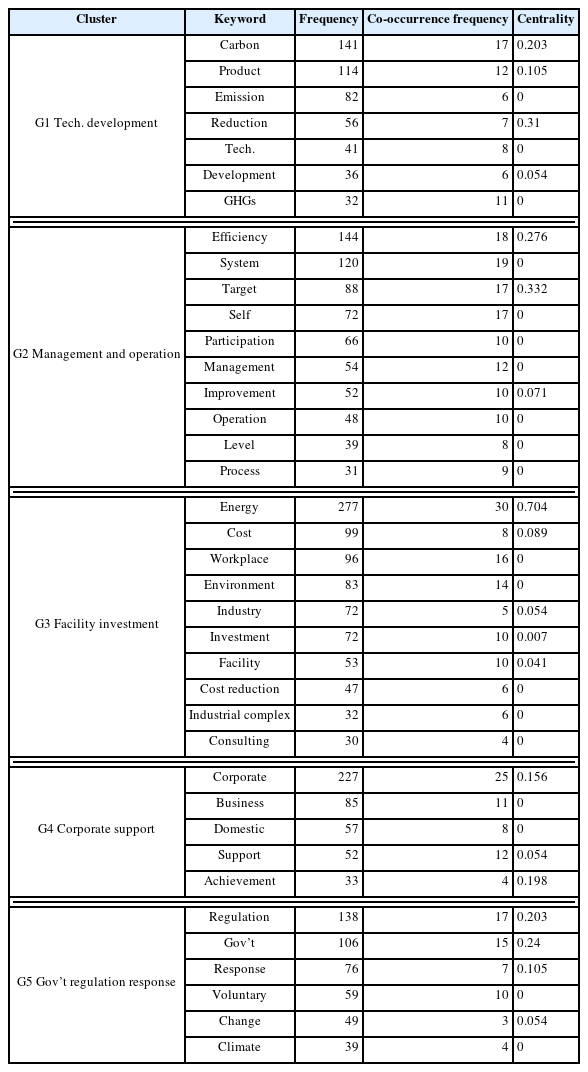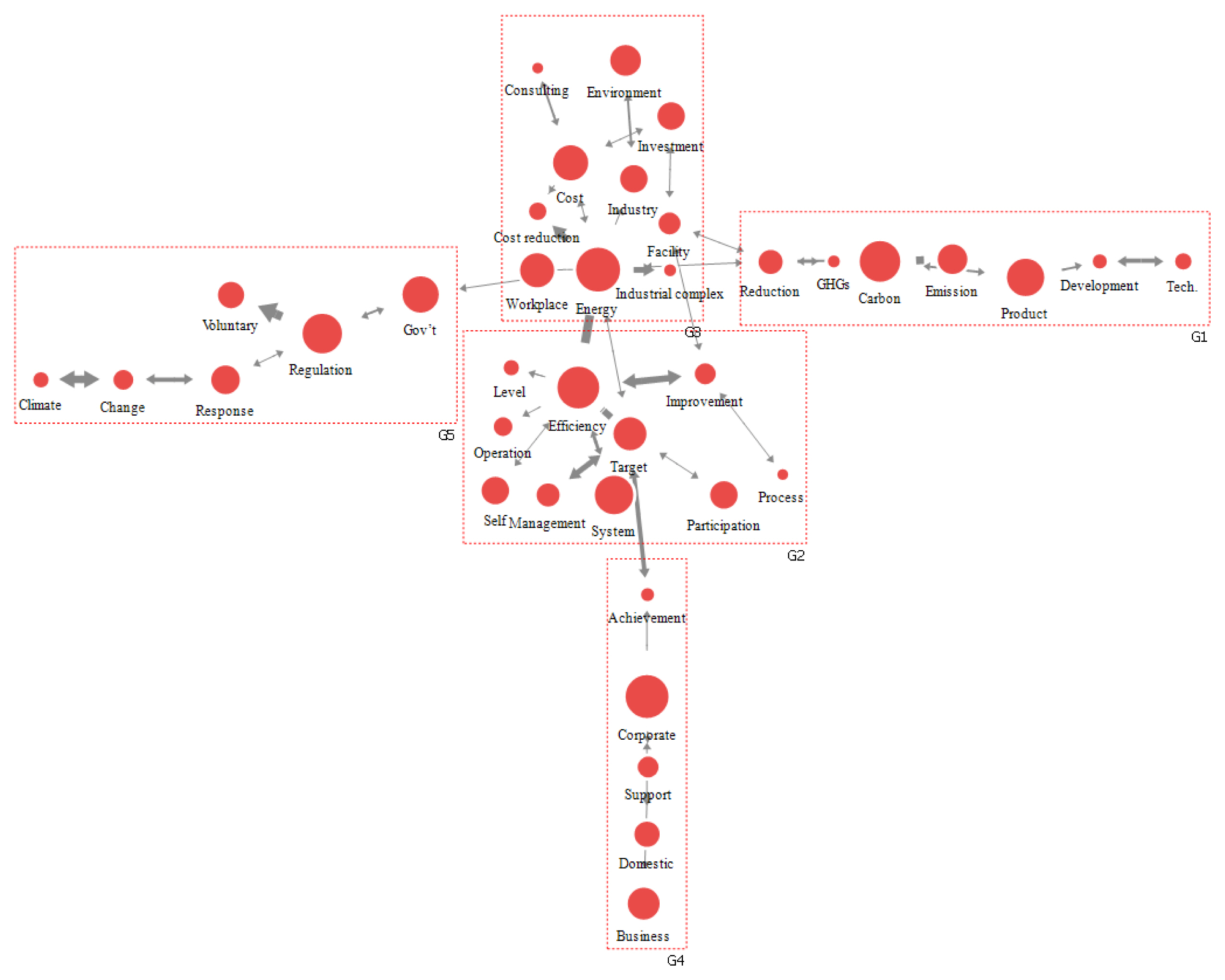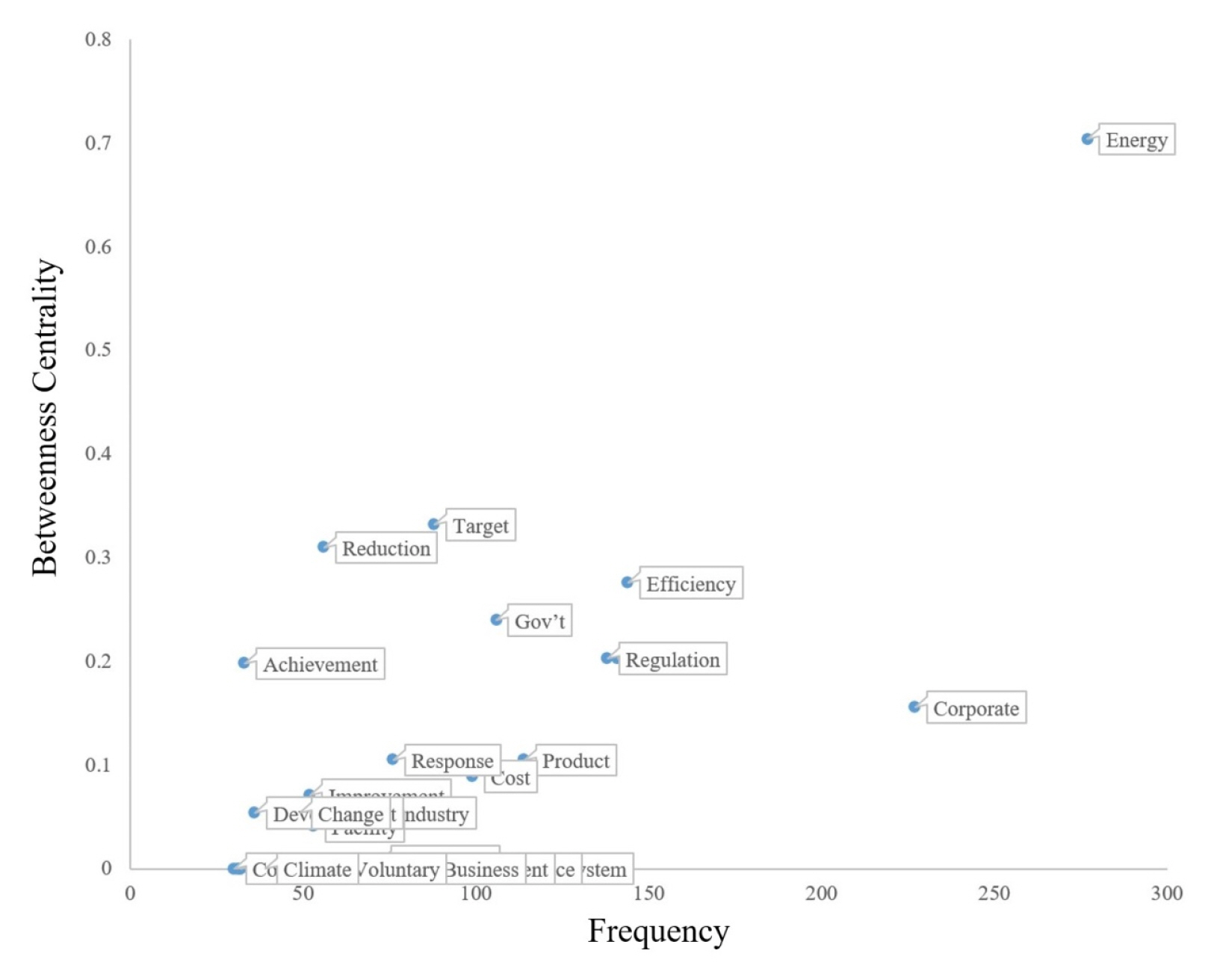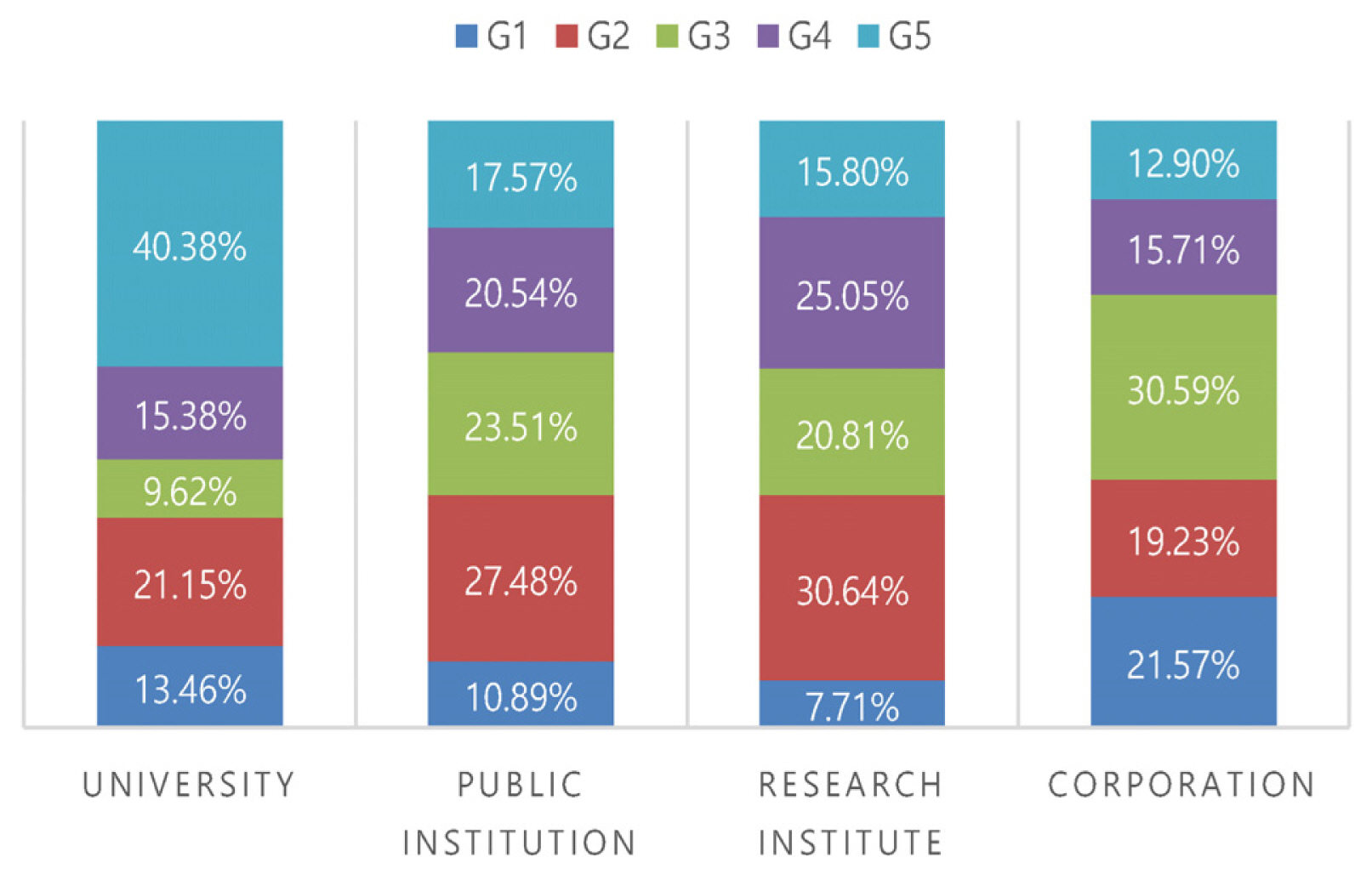Identifying Institutional Demand to Activate Self-Regulation for Climate Change
Article information
Abstract
Background and objective
Self-regulation has recently been implemented as an alternative solution to regulatory problems brought on by the inevitable delay of government-led regulations that cannot keep pace with environmental regulatory requirements in the field of climate change. The reality is that there has been insufficient preparation regarding implementing these alternative regulations to ensure that democratic support has been verified, and procedural legitimacy has been ensured.
Methods
This study aims to identify institutional demands measures that can stimulate self-regulation in the future by conducting interviews with people who currently engage in self-regulation in the field of climate and the environment.
Results
The analysis is categorized into five groups: G1 for technology development, G2 for management and operation, G3 for facility investment, G4 for corporate support, and G5 for government regulation response. By category, public institutions and research institutes show a high demand for issues related to management and operation. The highly centralized management and operation sector confirms that there is demand for greater policy enactment in postevaluation, which assesses the achievement of target levels.
Conclusion
Since systematic transitions such as climate change are associated with institutional changes in various fields along with technological development, policy coherence and policy integration are seen as vital to the management and operational aspect of systems established in previous studies.
Introduction
There has been growing interest in self-regulation as a new alternative to government regulation for climate change. Korea has long implemented self-regulation as an alternative solution (Gunningham, 1995; Korpela, 1992) to problems that arise from the inevitable lag in governmental regulatory response (Testa et al., 2011) especially as compared to other advanced countries and regions, such as the European Union (E.U.). However, self-regulation is still considered a concept that clashes with government regulation, with many perceiving that the natural role of government is to correct market failures. However, it is worth considering that the government may be limited in this respect in that it can be deflected by interest groups (Ostrom et al., 2012; Stiglitz, 2008). Despite its importance, insufficient preparations have been made for alternatives to government regulations to ensure that democratic input has been received and procedural validity guaranteed in their enactment. Therefore, this study aims to identify institutional demands measures to stimulate better self-regulation in the future by conducting interviews with people that have participated in self-regulation in the field of climate and the environment.
In the past, the international community has responded to climate change voluntarily without the mandatory enforcement of regulations (OECD, 2009). However, with the recent recognition of key terms, such as carbon neutrality, specific regulatory movements have begun to emerge. The United States (U.S.) and E.U. are at the center of discussions on climate change response, while the Korean government has launched a Carbon Neutrality Committee and has set climate change response as a national agenda (Lee et al., 2022). Currently, the existing legal system has limitations in responding to these areas of climate change, and it is difficult to quickly respond and adjust through government-led policy establishment. In fact, OECD (2009) suggests performance-based regulation, market-based instruments, and self- and co-regulation as alternatives to government regulation. Self-regulation emphasizes private sector cooperation and partnerships to effectively respond to climate change, and is presented as an alternative that complements the limitations of existing government regulations.
Korea has proposed the introduction of self-regulation as an alternative to new government regulations as a national-level task and is pursuing detailed policies related to this approach (Choi and Lee, 2009; Kim, 2022). However, there is still a lack of research on the institutional demands that would accurately reflect the opinions of direct policy participants. This study focuses on self-regulatory policies in the field of climate change, which is considered difficult to achieve through the policy goals and objectives of the existing government-led regulatory system. Interviews have been carried out with people that have participated in self-regulation in the field of climate change, to identify the institutional demands. This study is significant in that the content of the interviews has been coded and processed through semantic network analysis to accurately gauge opinions and ensure procedural validity in identifying alternative approaches to self-regulation.
Theoretical Background
Different researchers offer varying definitions of self-regulation; there is no single clear definition of the concept. In a broad sense, self-regulation has a collective, regulatory nature, with common rules or principles operating between various subjects. In a narrower sense, it may be described as a set of self-made rules that allow individual industries to operate according to their own principles. It is also defined as the agreement among firms in a particular industry, or an entire industry, to follow the same rules or principles (Baldwin et al., 1999). If the government becomes involved, it may become an obligatory form of regulation. Other definitions include the collective action of non-governmental subjects (Black, 2001) and the establishment of rules or standards for the behavior of firms within an industry (Castro, 2011). Self-regulation may also be implemented to change the subjects that build or operate the regulatory framework, rather than using an existing framework.
Widely recognized types of self-regulation are: mandated self-regulation, sanctioned self-regulation, coerced self-regulation, and voluntary self-regulation. Mandated self-regulation refers to a situation where the government takes the initiative to establish a self-regulatory organization (SRO), where the state’s intervention is strong. In the case of sanctioned self-regulation, the government reserves decision-making authority over the SRO in the process of authorizing and approving its establishment, and there are sanctions for SRO members. Voluntary self-regulation is characterized by the lowest level of state intervention, where there is an absence of government restrictions on establishing SROs, and there are no sanctions against members who participate in self-regulation (Choi and Lee, 2009).
There are also studies on platform-related self-regulation (Kim, 2022; Seon, 2022). Seon (2022) notes that self-regulation is difficult to define in a single form and has a broad spectrum, which necessitates considering industry-specific characteristics for effective policy alternatives. An objective evaluation regarding the need for self-regulation should be carried out by the industry for the successful establishment of self-regulation, and precedent studies on the validity of self-regulation and the implementation of suitable, or tailored models per relevant issues are needed. In particular, Sun finds that a one-size-fits-all self-regulatory governance system is deemed inappropriate in new industries, which are complex and less predictable. It is important to identify the advantages and disadvantages of each type of self-regulation and review domestic and international practices on the matter. Kim (2022) argues that the preferred type of online platform self-regulation is industry-led, where the most relaxed approach to the legal basis and scope of self-regulation is appropriate. Evidently, domestic self-regulation studies are limited by arguments about the need for a review or preliminary research on introducing self-regulation in specific fields.
Beyond the abovementioned discussion on self-regulation, several studies have focused on self-regulation in the field of climate change specifically. Climate change-related self-regulation discussions are more specific than other fields in that they cover data, standards, and the impact of government systems. First, studies on climate change data-related self-regulation examine how environmental discourse affects carbon disclosure regulation, such as carbon disclosure practices and the availability of such information. Andrew and Cortese (2011) found that methodological diversity underpinning carbon disclosure can hinder the utility of climate change-related data.
Private sector insurance has begun incorporating climate change elements into its standard business practices. ClimateWise is an example of one of the organizations making efforts concerning self-regulation. It is a self-regulatory organization established to address climate change risks and was led through government efforts (Thistlethwaite, 2012). Hsueh and Prakash (2012) studied how program sponsorship affects the design of voluntary programs. The research question was why and how state and federal government-sponsored voluntary climate change programs differ in their institutional designs. This study provides an empirical analysis of how the tangible and intangible effects of participating in voluntary programs differ between state and federal level governments. Existing research on self-regulation in the field of climate change mainly focuses on specific institutional cases, while there remains a lack of studies that analyze the opinions of key persons participating in the system to identify policy needs.
Therefore, this study can help to overcome the limitations of existing studies by providing direct implications through an identification of policy demands for the future advancement of self-regulation through interviews with people who have actively participated in self-regulation in the field of climate change. In addition, by interviewing people involved in climate change self-regulation, this study provides policy implications that go beyond precedent studies that have investigated or reviewed specific cases for the introduction of self-regulatory systems.
Research Methods
This study focuses on real cases of active self-regulation in the field of climate change response to understand the perceptions and specific circumstances of expert groups and private business groups for each system. Self-regulation, for this study, does not constitute government-imposed regulations, but rules that are centered on private associations and organizations, or rules voluntarily complied with by companies themselves. Various forms of self-regulation exist depending on the degree of regulation placed on members and the presence (or absence) of legal bases. In the field of climate change response, the Voluntary Energy Efficiency Target System has companies sign a contract with the Korea Energy Agency (KEA) to voluntarily reduce the energy consumption of energy-intensive workplaces in the industrial power generation sector. The Environmental Declaration of Product (carbon field) is a system that converts the amount of greenhouse gases (GHGs) generated in all processes of supplying products and services into carbon dioxide emissions and labels them accordingly. Low-carbon product certification can be obtained by meeting the low-carbon product declaration; this may be regarded as self-regulation in that participation in the system is not mandated by the government, but is a choice made by companies.
This study carried out focus group interviews with people involved in the Voluntary Energy Efficiency Target System and Environmental Declaration of Product (EDP). The researchers provided an outline of questions to survey takers, who responded with open-ended answers. The inputs of experts from each organization were recorded and analyzed during meetings set up on the online conference platform Zoom. The collected video and audio data were converted into text files using Naver Clova.
The researchers analyzed the data collected from stakeholders in the climate environment sector, where self-regulatory systems have already been introduced or have completed their first phase of operation, to understand the characteristics of each subject, and to thus more accurately identify their policy demands. Through this analysis, this study aims to provide implications for future policy development on self-regulation, by focusing on the persons participating in the system and identifying their related policy demands, reaching beyond existing studies that only examine the systems themselves.
First, a group of experts was assembled to investigate the current state of regulation and self-regulation in the field of climate change response, with a particular emphasis on researchers and professionals associated with the Voluntary Energy Efficiency Target System and EDP, which are representative cases of self-regulation in Korea. Second, focus group interviews (FGIs) were conducted to investigate corporate responses and policy demands related to the recent strengthening of regulations on climate change response in Korea. The interviews were conducted in September 2022(1 Sep. – 26 Sep.), and 17 people were interviewed for a total of 9 times. Interviews were conducted in the field of the voluntary energy efficiency target system and environmental declaration, which are representative self-regulatory systems in the field of climate change, and were mainly conducted with experts in related systems and participating companies. In particular, interviews were conducted with key personnel from domestic climate change specialized organizations such as Korea Institute of Energy Technology Evaluation and Planning, Korea Energy Economics Institute, Korea Energy Agency, and Korea Environmental Industry and Technology Institute, and the team was comprised of experts who could represent the relevant field. Third, through frequency analysis, words with high frequency were selected, with nouns as the main keywords extracted from the top 10% of the most frequently appearing words (Luhn, 1958). Fourth, semantic network analysis was carried out to perform cluster analysis of betweenness centrality between words. Finally, the text files of the interviews and the recordings of the actual interviews were cross-compared to identify the meanings delivered by each stakeholder and group. For the analysis by group, five groups were selected that were easy to interpret as a result of the factor analysis that emerged as a result of the semantic network analysis.
Results and Discussion
The results are divided into five groups: G1 (technology development); G2(management and operation); G3 (facility investment); G4 (corporate support); and G5 (government regulation response). Based on the visual analysis of the semantic network, G2 (management and operation) is at the center of the network, confirming the importance of this issue in the discussion of self-regulation for climate change. However, although G2 has high centrality in terms of location, if it look at the central value, it evaluated that G3 is composed of words with a higher centrality index than G2. Other issues, such as technology development related to GHG reduction, facility investment to reduce energy costs, support for companies to achieve climate change targets, and related government regulation responses, are distributed in close proximity (see Table 1).
First, in G1, which is the group focused on technology development related to GHGs and carbon products, keywords like “carbon,” “product,” and “reduction” were extracted, confirming that carbon reduction technologies related to GHG mainly center on the unit of “product.”
Second, G2 verifies that keywords like “efficiency,” “target,” and “improvement” are central to the issue of self-regulation in the climate and environmental field. It is confirmed that there is a policy demand for the improvement of existing systems through the presence of keywords related to management and operations. It is noteworthy that there are demands for policies on post-evaluation, which assesses whether existing target levels have been reached, through keywords like “improvement,” “target,” and “level” with regard to management and operation.
Third, “energy,” “cost,” “industry,” and “facility” are identified as keywords in issues related to facility investment (G3), through which it is determined that companies are trying to reduce energy costs by investing in workplace facilities. Consulting fees are required when investing in energy-related facilities, but the KEA is shown to support these costs.
Fourth, G4 is related to corporate support, and is primarily concerned with projects to achieve GHG reductions for domestic companies.
Lastly, G5 covers issues related to government regulation response, where there is a transition to the keyword “voluntary” in respect to the government regulation response to climate change (see Fig. 1).
Fig. 2 shows the top keywords for betweenness centrality and frequency. The keywords that present high betweenness centrality and frequency are “energy,” “business,” and “efficiency,” which demonstrates the companies’ strongest interests in energy efficiency as their self-regulatory response to climate change. The keywords with low frequency but high betweenness centrality are “target,” “reduction,” and “achievement,” indicating that companies implement climate change response strategies based on clear reduction targets. Meanwhile, the keywords close to the government are “target,” “regulation,” reduction, and “achievement,” which signify that achievements, as opposed to targets, are perceived as important issues with regard to governmental response.
Table 2 describes the characteristics of each subject. First, in the case of universities, respondents demonstrated high frequency for G5 - government regulation response. The results of this study indicate that academic discussions and discussions on the role of government in actual self-regulation are actively underway. In the case of public institutions, G2 - management and operation, G3 - facility investment, and G4 - corporate support are the main topics. High frequency is particularly evident in issues related to management and operation, which occupy the most central position in the semantic network (see Table 2 and Fig. 3).
Issues related to management and operations are particularly high among public institutions and research institutes, confirming a high level of interest in the actual management and operation aspects of climate change-related self-regulation discussions. Research institutes also demonstrate a high level of frequency in the G4 corporate support group. This indicates that the need to provide an incentive structure for companies to participate in the system by offering various support measures is frequent in government responses related to climate change adaptation. Companies are highly interested in facility investment, which suggests that companies, such as those that are members of the RE100, are investing in facilities as a response to climate change adaptation at the corporate level. Companies are also highly interested in technological development related to climate change adaptation, and there is a high demand for policies on continuous monitoring of the legal system for government-level management and operation.
Regulatory reform has been prioritized in the Korean national agenda since the new government’s inauguration in 2022. The government has announced the introduction of a self-regulatory system, which indicates a high level of interest in selecting applicable fields and institutional establishment. This study identifies institutional demands and policy demands by analyzing interviews with people participating in the Voluntary Energy Efficiency Target System and EDP, which are representative cases of self-regulation in the climate environment field.
Korea is highly ranked in the Framework for Regulatory Policy Evaluation published by the Organization for Economic Co-operation and Development (OECD) in 2022. Korea is ranks especially high in terms of stakeholder engagement and regulatory impact analysis, but low in the area of post-evaluation. To enhance the impact of regulatory policies, Korea has given much attention to the participation and pre-evaluation of subjects, and has been actively promoting related policies. However, it has only recently begun to study institutional demands measures for postevaluation (Lee, 2017; Lee et al., 2019). A smooth operational mechanism for institutions and organizations should be formed to develop effective policy improvements in the evaluation aspect of the regulatory reforms that Korea is promoting.
Since institutional transitions such as those needed in the field of climate change are linked to institutional changes across various fields, along with technological development, policy coherence and integration will emerge as important issues regarding the management and operation of the system, as determined by the findings of this study. For instance, as various departments need to promote policies with a common goal in mind. Thus, institutional operation and management will emerge as key topics in maintaining consistent policy integration across different departments. Therefore, it is vital to identify institutional demands for stimulating self-regulation in the future through theoretical research on policy consistency to provide guidance.
Conclusion
This study analyzes the differences in perceptions about self-regulatory systems related to climate change response by people actively involved in self-regulation. The results are divided into five groups: G1 - technology and development, G2 - management and operation, G3 - facility investment, G4 - corporate support, and G5 - government regulation response. The results show that the network is predominantly centered on management and operations (G2). The results of semantic network analysis, it was confirmed that although a network was formed centered on contents related to management and operation (G2), the words with the highest centrality were in the G3 group. By subject, public institutions and researcher institutes show a high policy demand for issues related to management and operation. Based on the words “improvement,” “goal,” “level,” and “process,” it is determined that there is a strong policy demand for improvements in the post-evaluation area, which evaluates the achievement of existing target levels, in the highly centralized management and operations sphere.
To effectively promote regulatory policies, the linkage between each stage of the system - pre, post, and feedback - must be systematically organized and operated. It is important to maintain institutional coherence by establishing a scientific decision-making structure to identify feedback on how institutional demands can be made in the management and operation of the system (Yang, 2009). Therefore, this study is significant in that it identified policy completion in the climate field regarding self-regulation as an alternative to existing government-led regulatory issues (Gunningham, 1995; Testa et al., 2011).
The findings show that companies are highly interested in technology development, and there is a strong demand for policies on continuous monitoring at the government level, such as by providing information on related global legal systems. The results suggest an increased demand for policies on management and operation of self-regulatory issues related to future climate change adaptation, and that policy support systems should be strengthened, especially for postevaluation. This study proposes the need for institutional demands regarding the post-evaluation aspect of climate change self-regulation so that it can collect the views of participating individuals and provide feedback in the future.




